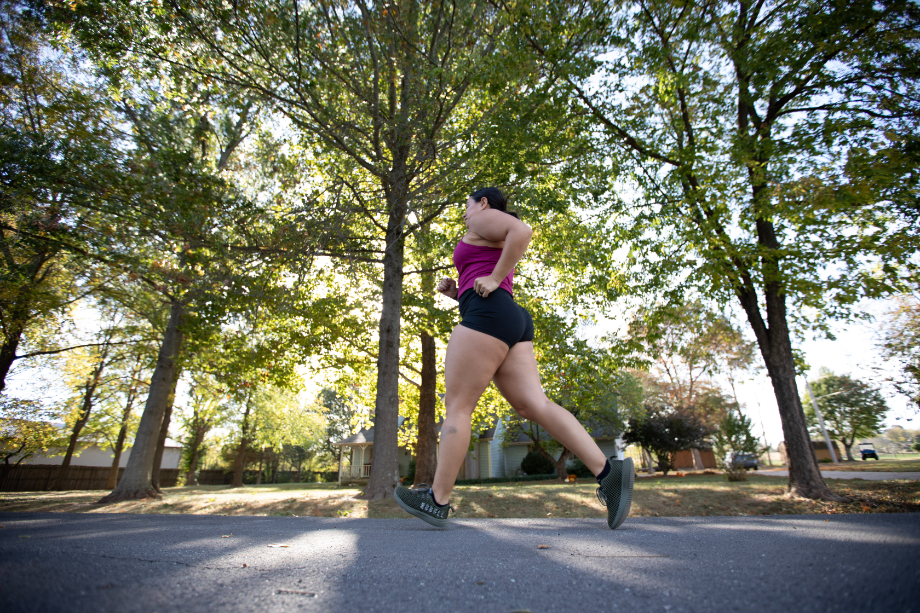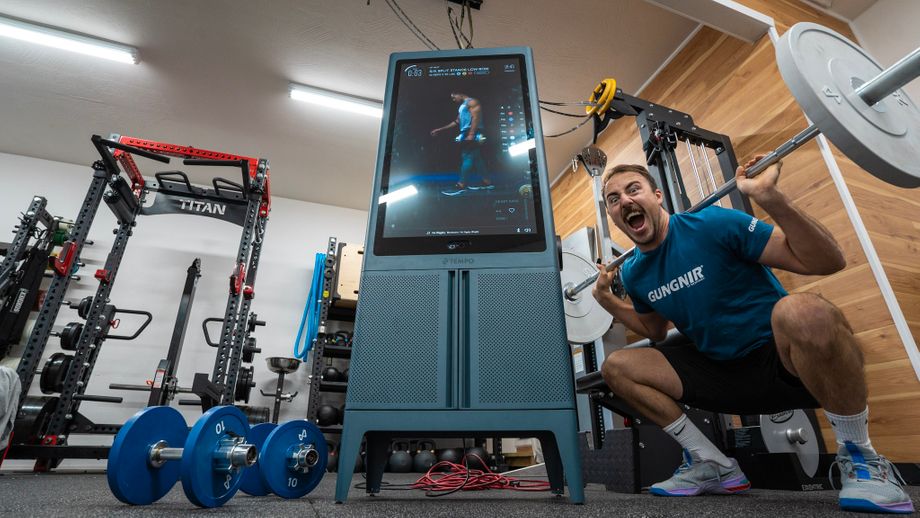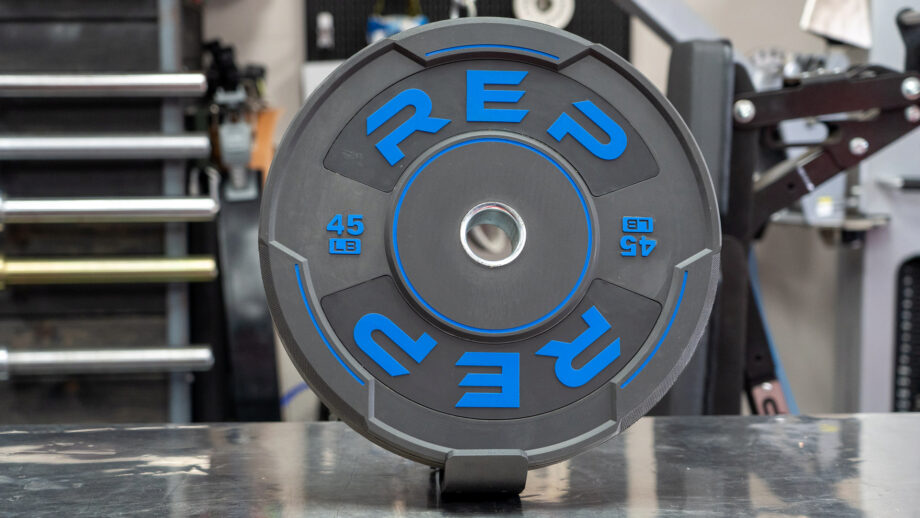When trying to hit walking goals, there are generally two ways to measure progress: number of steps or total miles. If you’re using a fitness tracker, you’ll generally get a step count, but it’s not always translated to miles.
But knowing how many steps are in a mile can make it easier to measure your progress toward specific walking targets, and keep you on track with your overall fitness goals. It can also help you assess your total physical activity more accurately.
RELATED: Fitness Tracker Metrics 101
So, what’s the answer? How many steps are in a mile? The very vague answer is, “It depends.”
Your height, specific step length, and speed largely influence how many steps it takes to go any amount of distance. The type of terrain you’re walking or running on also affects how much ground you’ll cover in a specified number of steps.
That being said, there are some averages you can go by. In this guide, we’ll go over the average number of steps in a mile based on different factors, as well as how to calculate exactly how many you actually take.
Average Number of Steps in a Mile
According to the University of Oklahoma, women have an average step length of 2.2 feet and an average stride length of 4.3 feet. For men, this jumps to 2.5 feet and 5.2 feet, respectively. Based on these averages, there are about 2,112 to 2,400 steps in a mile.
But, as we mentioned above, if you want highly accurate numbers, it’s not that simple. Your walking pace, height, and the type of terrain play a huge role.

“Walking steps are not the same as running steps. You’ll take considerably more steps during two miles of walking than you will running for two miles,” says Amanda Capritto, certified personal trainer and health coach. “Incline miles are also different from decline miles. Stride length decreases1 when you’re going uphill and increases when you’re moving downhill2.”
All that considered, it’s impossible to tell you exactly how many steps you take per mile, but here’s a better average breakdown from the ACSM’s Health & Fitness Journal3 based on different walking, jogging, and running speeds.
When Walking
| Men | Women | |
| 20-minute mile (average walking pace) | 2,176 | 2,310 |
| 15-minute mile (brisk walk) | 1,868 | 1,987 |
When Jogging
| Men | Women | |
| 12-minute mile | 1,919 | 1,979 |
| 10-minute mile | 1,635 | 1,709 |
When Running
| Men | Women | |
| 8-minute mile (fast run) | 1,360 | 1,469 |
| 6-minute mile (very fast run) | 1,064 | 1,213 |
How to Measure Your Steps
While these ballpark numbers are helpful, there are a lot of factors that come into play. Men and women have different heights, gaits, and stride lengths.
To that end, if you want a more accurate assessment of how many steps you take per mile, you can physically test it out by counting the number of steps you take to cover a certain distance and then doing some math to convert it as needed. There are a few ways to do it.
Note: You can use one of the best fitness trackers, like a Fitbit or Apple Watch, or a pedometer to record your steps, but counting them in your head may be more accurate since these tools sometimes miscount, which can result in a readout that has fewer steps than you actually took.
Pre-Measured Mile

One of the easiest ways to determine how many steps it takes you to walk a mile is to actually walk the mile. You can measure out a mile in a walking app, like MapMyWalk or Footpath Route Planner, and then hit the pavement counting how many steps it takes you to complete the route. You can also do this with a half-mile and multiply your results by two.
Track
A track is another option. If your local gym doesn’t have one, many schools will allow you to use theirs after hours; just make sure to okay it with the administration first.
A standard track is a quarter-mile (1,320 linear feet) on the inside lane. Walk the track, counting your steps as you go. You can go around once, then multiply the number by four, or go around four times for a full mile. “Make sure you’re using a standard quarter-mile track and not a 400-meter track,” says Amanda. “Some school tracks aren’t a full quarter-mile, which can skew your results.”
Football Field
A football field, which measures 300 feet from goal post to goal post, is another option. Walk in a straight line from end to end once, counting your steps as you. When you’re done, multiply your result by 17.6.
Amanda says it’s best to do these “tests” a few times and then calculate an average step count with all the results. This helps account for random variations in step length or speed and gives a more accurate number.
How to Measure Your Step Length
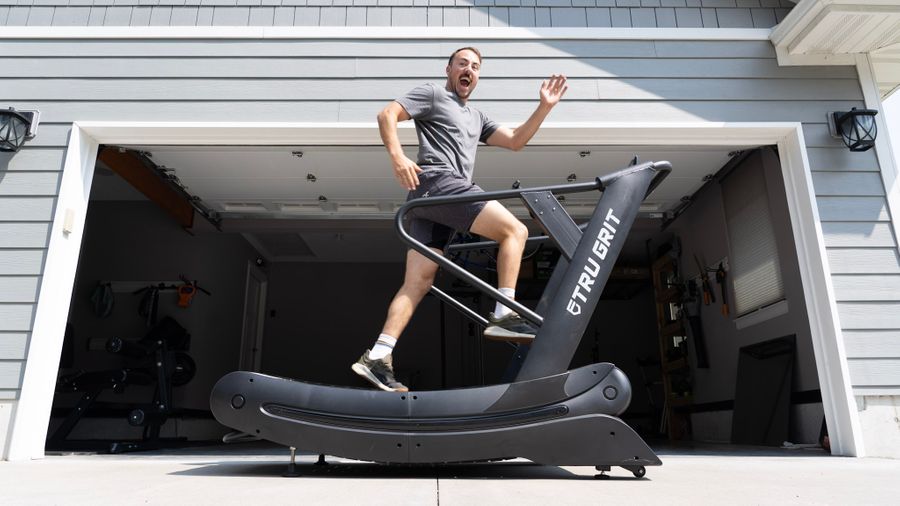
You can also estimate how many steps you take per mile by calculating your step length. For reference:
- Step length is the distance from heel to heel when you take one full step.
- Stride length is the total distance covered when you take two steps.
There are two methods you can use to measure your step length.
Short Distance
If you want to do this at home, you can use a short distance measurement of about 50 feet. To measure:
- Get a piece of chalk or some painter’s or duct tape.
- Go outside and measure a straight line of 50 feet. Mark each end with the chalk or tape.
- Stand about 20 feet back from the start of your marked line, and start walking at your normal pace.
- Once you hit the chalk or tape, start counting your steps until you reach the other marked end.
- When you have your number, divide the total feet (50) by the number of steps you took. For example, if it took you 24 steps to get from end to end, you would divide 50 by 24 to come up with a step length of roughly 2.1 feet.
Long Distance
You can also do this with longer distances, like a 300-foot football field. The concept is exactly the same.
- Find a standard football field and stand about 20 feet behind the goal post. Start walking at your normal pace.
- Once you line up with the goal post, start counting your steps until you reach the other goal post.
- When you have your number, divide the total feet (300) by the number of steps you took. For example, if it took you 144 steps to get from end to end, you would divide 300 by 144 to come up with the same step length of roughly 2.1 feet.
Once you have your step length, you can divide the number of feet in a mile (5,280) by your individual step length. In these examples, your estimated steps per mile would come out to 2,514.
Keep in mind that the exact number of steps in any given mile still varies depending on your running or walking speed and the terrain. When you’re running, you have a much longer stride length than when you’re walking, but this will give you a more accurate assessment compared to just speaking in averages.
RELATED: How Many Calories Does Wlaking A Mile Burn
How Do You Calculate Stride Length?
Now that you know how to calculate step length, next up is stride length. And that calculation is a straightforward process. Here’s what you do:
- Measure a specific distance, say 30 feet, and then mark each end with tape or chalk.
- Start walking about 15 feet before the first mark so you can settle into your natural stride.
- Once you hit the first mark, count your steps until you hit the second mark.
- Divide the measured distance by the number of steps you took.
For example, if it took 80 steps to walk 30 feet, your stride length would be 80 divided by 30, or 2.67 feet (32 inches).
Another option is to use a general calculation, although it won’t be as accurate as counting your own steps. For the general calculation, you multiply your height in inches by 0.414. That number is the average stride length based on height.
Once you know your stride length, you can calculate your steps in a mile from there by doing either of the following:
- Dividing 5,280 by your stride length in feet
- Dividing 63,360 by your stride length in inches
How Many Steps Should You Take Each Day?
There’s common advice floating around that you should take 10,000 steps per day. But that can be a lofty goal for some (especially if you’re currently sedentary). Right now, the average American takes 3,000 to 4,000 steps per day4, so 10,000 can be a big jump right off the bat.
Plus, there’s no solid science that says 10,000 steps is some magic number. In fact, this step goal started as a marketing campaign for a pedometer and somehow took off and became commonplace despite the lack of evidence.
So, how many steps should you take each day? Well, it depends how many steps you’re taking now. The best approach to building sustainable habits is to slowly increase your efforts over time, giving your body (and mind!) time to adjust.
Research shows that just walking an extra 1,000 steps per day can lower the risk of all-cause mortality and heart disease by 6% to 36%5. And for each additional 1,000 steps you take, that risk lowers even more. But that doesn’t mean you have to spend all day walking.

In a study published in JAMA Internal Medicine6, researchers found that women who took about 4,400 steps per day had a 41% lower risk of death from all causes than those who took 2,700 steps per day. And while the risk continued to decrease with higher step count numbers, the effects leveled off around 7,500.
What’s even more interesting is that step intensity didn’t play a major role in the benefits. In other words, the number of steps taken was more important than the intensity of those steps.
The take-home message? You can go slow, just go.
To put this in practice, we recommend figuring out your current baseline and then slowly increasing that number until you reach around 7,500 steps per day.
If you currently take 2,000 steps per day, aim to increase that number to 3,000 daily steps for the next week. Once you consistently walk 3,000 steps, increase that number to 4,000 daily steps for a week. Then continue this pattern until you hit 7,500.
Here’s what that might look like:
| Starting point | 2,000 steps |
| Week 1 | 3,000 steps |
| Week 2 | 4,000 steps |
| Week 3 | 5,000 steps |
| Week 4 | 6,000 steps |
| Week 5 | 7,000 steps |
| Week 6 | 7,500 steps |
How To Get More Steps
One of the easiest ways to get more steps is to do a structured treadmill workout or set aside 30 minutes to take a planned walk outside. But there are lots of little things you can do during the day to up your step count.

Here are some ideas:
- Take the stairs instead of the elevator
- Pace around the room any time you’re talking on the phone
- If you’re watching TV, get up and walk around the room every time a commercial comes on
- Walk on a walking pad during meetings or while you watch TV
- Park in the farthest parking spot whenever you’re doing errands
- Pace when you’re waiting for the oven to preheat or food to finish microwaving
- Set a reminder on your phone to get up and walk up and down the stairs a few times every half hour
- Walk a couple extra laps around the grocery store when you’re shopping
- Make it a competition—get a friend involved to see who can get the most steps in
Step Chart
As mentioned, your height is one of the factors that plays a role in your stride length, which affects exactly how many steps are in your mile. Again, it’s worth stressing that it’s only one of the factors, but if you don’t need exact numbers (just very close ballparks), you can use the below chart to get a closer estimate of the steps in a mile based on your height.
(Note this chart uses the average stride lengths calculated by multiplying height in inches by 0.414.)
| Height | Average Stride Length | Steps in a Mile |
| 4′ 10″ | 24.012 | 2,639 |
| 4′ 11″ | 24.426 | 2,594 |
| 5′ | 24.84 | 2,551 |
| 5′ 1″ | 25.254 | 2,509 |
| 5′ 2″ | 25.668 | 2,468 |
| 5′ 3″ | 26.082 | 2,429 |
| 5′ 4″ | 26.496 | 2,391 |
| 5′ 5″ | 26.91 | 2,355 |
| 5′ 6″ | 27.324 | 2,319 |
| 5′ 7″ | 27.738 | 2,284 |
| 5′ 8″ | 28.152 | 2,251 |
| 5′ 9″ | 28.566 | 2,218 |
| 5′ 10″ | 28.98 | 2,186 |
| 5′ 11″ | 29.394 | 2,156 |
| 6′ | 29.808 | 2,126 |
| 6′ 1″ | 30.222 | 2,096 |
| 6′ 2″ | 30.636 | 2,068 |
| 6′ 3″ | 31.05 | 2,041 |
| 6′ 4″ | 31.464 | 2,014 |
| 6′ 5″ | 31.878 | 1,988 |
Benefits of Daily Walking
Walking is having its moment in the spotlight, and rightfully so. Aside from the facts that it’s easily accessible and low-impact (so it’s also easy on the joints), walking comes with a bunch of other health benefits. Most notably, research shows that walking may:
- Improve cardiovascular health7 by reducing blood pressure, increasing aerobic activity, and decreasing weight and waist circumference
- Help with weight loss8
- Strengthen bones9
- Increase lower-body strength10 and improve mobility
- Improve mood11 and overall well-being
- Contribute to better brain health12
- Help with digestion13 and reduce constipation14
- Improve sleep15
And if you take your walk outside, there may be additional perks if you’re surrounded by some greenery (grass and trees): Research shows that walking outdoors may increase stress resilience, boost well-being, and improve immune function16.
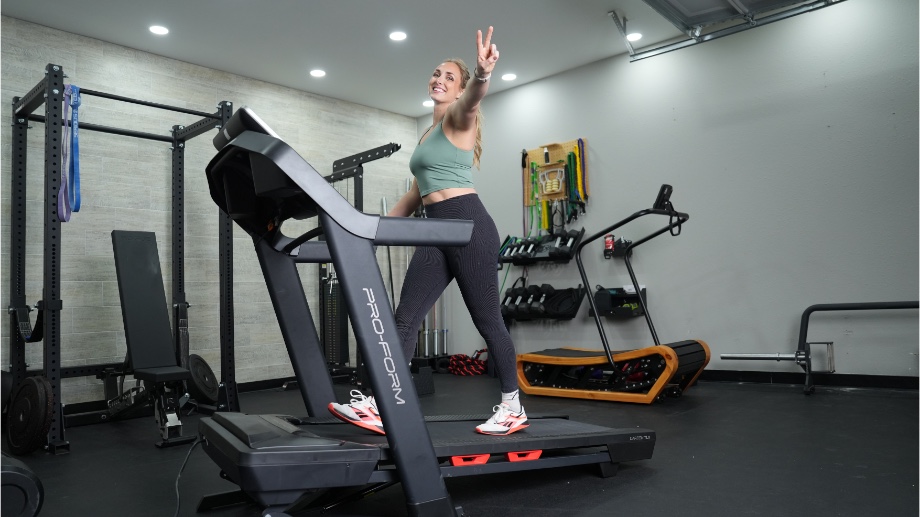
If you want to take things up a notch and get some additional benefits, you can also add extra weight to your walks via a weighted vest, ankle weights, and/or wrist weights.
Using weights increases the intensity of your workout, which can help burn more calories and improve overall body composition17—aka reduce body fat while increasing lean muscle mass
How Many Steps in a Mile: Final Thoughts
On average, there are about 2,112 to 2,400 steps in a mile. But there’s really no “average person,” and the exact number largely depends on your speed, height, and whether you’re moving up or downhill. If you’re trying to meet a daily step goal and you want to get specific, it’s best to measure your own step length to get a more accurate estimate.
How Many Steps In a Mile: FAQs
How many miles is 10,000 steps?
If you’re trying to reach a daily goal of 10,000 steps, you probably want to know how much mileage you’ll log at the end of the day. Since there are about 2,112 to 2,400 steps in a mile (depending on your step length), you’ll get in 4.2 to 4.7 miles total.
Does 5,000 steps equal one mile?
Five thousand steps is closer to two miles, or 2.08 to 2.4 miles, when working with the average step numbers.
Does walking help reduce belly fat?
Walking is an excellent (and often underrated) form of physical activity. Not only does it boost your fitness level, it also comes with other health benefits, like reduced blood pressure and weight loss, as long as you stay consistent. While you can’t spot reduce belly fat, walking can help you burn calories and contribute to overall body fat reduction when combined with a healthy diet.
References
- Padulo J, Annino G, Dʼottavio S, Vernillo G, Smith L, Migliaccio GM, Tihanyi J. Footstep analysis at different slopes and speeds in elite race walking. J Strength Cond Res. 2013 Jan;27(1):125-9. doi: 10.1519/JSC.0b013e3182541eb3. PMID: 22450256.
- Long, Ben. Muscle Work Discrepancy during Incline and Decline Running at Three Speeds. ResearchGate. Accessed August 30, 2022.
- Hoeger, Werner W.K. Ed.D., FACSM; Bond, Laura M.S.; Ransdell, Lynda Ph.D., FACSM; Shimon, Jane M. Ed.D., A.T.C.; Merugu, Sunitha B.S., P.T.. ONE-MILE STEP COUNT AT WALKING AND RUNNING SPEEDS. ACSM’s Health & Fitness Journal 12(1):p 14-19, January 2008. | DOI: 10.1249/01.FIT.0000298459.30006.8d
- Mayo Foundation for Medical Education and Research. (2020, March 23). 10,000 steps a day: Too low? too high?. Mayo Clinic. https://www.mayoclinic.org/healthy-lifestyle/fitness/in-depth/10000-steps/art-20317391
- Hall KS, Hyde ET, Bassett DR, Carlson SA, Carnethon MR, Ekelund U, Evenson KR, Galuska DA, Kraus WE, Lee IM, Matthews CE, Omura JD, Paluch AE, Thomas WI, Fulton JE. Systematic review of the prospective association of daily step counts with risk of mortality, cardiovascular disease, and dysglycemia. Int J Behav Nutr Phys Act. 2020 Jun 20;17(1):78. doi: 10.1186/s12966-020-00978-9. PMID: 32563261; PMCID: PMC7305604.
- Lee I, Shiroma EJ, Kamada M, Bassett DR, Matthews CE, Buring JE. Association of Step Volume and Intensity With All-Cause Mortality in Older Women. JAMA Intern Med. 2019;179(8):1105–1112. doi:10.1001/jamainternmed.2019.0899
- Murtagh EM, Nichols L, Mohammed MA, Holder R, Nevill AM, Murphy MH. The effect of walking on risk factors for cardiovascular disease: an updated systematic review and meta-analysis of randomised control trials. Prev Med. 2015 Mar;72:34-43. doi: 10.1016/j.ypmed.2014.12.041. Epub 2015 Jan 8. PMID: 25579505.
- Donnelly JE, Honas JJ, Smith BK, Mayo MS, Gibson CA, Sullivan DK, Lee J, Herrmann SD, Lambourne K, Washburn RA. Aerobic exercise alone results in clinically significant weight loss for men and women: midwest exercise trial 2. Obesity (Silver Spring). 2013 Mar;21(3):E219-28. doi: 10.1002/oby.20145. PMID: 23592678; PMCID: PMC3630467.
- Zhang S, Huang X, Zhao X, Li B, Cai Y, Liang X, Wan Q. Effect of exercise on bone mineral density among patients with osteoporosis and osteopenia: A systematic review and network meta-analysis. J Clin Nurs. 2022 Aug;31(15-16):2100-2111. doi: 10.1111/jocn.16101. Epub 2021 Nov 1. PMID: 34725872.
- Rodio A, Fattorini L. Downhill walking to improve lower limb strength in healthy young adults. Eur J Sport Sci. 2014;14(8):806-12. doi: 10.1080/17461391.2014.908958. Epub 2014 Apr 23. PMID: 24754630.
- Zhu Z, Chen H, Ma J, He Y, Chen J, Sun J. Exploring the Relationship between Walking and Emotional Health in China. Int J Environ Res Public Health. 2020 Nov 27;17(23):8804. doi: 10.3390/ijerph17238804. PMID: 33260796; PMCID: PMC7734587.
- Chou CC, Chien LY, Lin MF, Wang CJ, Liu PY. Effects of Aerobic Walking on Memory, Subjective Cognitive Complaints, and Brain-Derived Neurotrophic Factor Among Older Hypertensive Women. Biol Res Nurs. 2022 Oct;24(4):484-492. doi: 10.1177/10998004221098974. Epub 2022 May 4. PMID: 35507447.
- Bellini A, Nicolò A, Bazzucchi I, Sacchetti M. The Effects of Postprandial Walking on the Glucose Response after Meals with Different Characteristics. Nutrients. 2022 Mar 4;14(5):1080. doi: 10.3390/nu14051080. PMID: 35268055; PMCID: PMC8912639.
- Gao R, Tao Y, Zhou C, Li J, Wang X, Chen L, Li F, Guo L. Exercise therapy in patients with constipation: a systematic review and meta-analysis of randomized controlled trials. Scand J Gastroenterol. 2019 Feb;54(2):169-177. doi: 10.1080/00365521.2019.1568544. Epub 2019 Mar 7. PMID: 30843436.
- Sullivan Bisson AN, Robinson SA, Lachman ME. Walk to a better night of sleep: testing the relationship between physical activity and sleep. Sleep Health. 2019 Oct;5(5):487-494. doi: 10.1016/j.sleh.2019.06.003. Epub 2019 Jul 26. PMID: 31358470; PMCID: PMC6801055.
- Legrand FD, Jeandet P, Beaumont F, Polidori G. Effects of Outdoor Walking on Positive and Negative Affect: Nature Contact Makes a Big Difference. Front Behav Neurosci. 2022 Jun 3;16:901491. doi: 10.3389/fnbeh.2022.901491. PMID: 35726335; PMCID: PMC9206539.
- Normandin E, Yow D, Crotts C, Kiel J, Beavers KM, Nicklas BJ. Feasibility of Weighted Vest Use during a Dietary Weight Loss Intervention and Effects on Body Composition and Physical Function in Older Adults. J Frailty Aging. 2018;7(3):198-203. doi: 10.14283/jfa.2018.17. PMID: 30095153; PMCID: PMC6489119.


